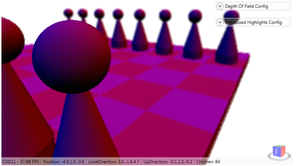Information
- Publication Type: Bachelor Thesis
- Workgroup(s)/Project(s):
- Date: September 2015
- Date (Start): 15. September 2014
- Date (End): 15. September 2015
- Matrikelnummer: 1126633
- First Supervisor:
- Keywords: depth-of-field, deferred rendering, real-time rendering
Abstract
This bachelor’s thesis is about a depth of field rendering algorithm using point splatting on per-pixel layers. The intuitive procedure just uses specific adjustable parameters for the lens of a camera to generate the desired effect in real-time. Using nothing but the depth information of a scene, the depth of field can be computed.
The so called circles of confusion are the representing value of the blur rate for objects that are out of focus. Depending on the distance between the focal plane and the current pixel, an expansion takes place because of the redirecting nature of a lens. The following required information is retrieved using an intensity distribution function.
To avoid intensity leakage and provide a full opaque picture, the entire effect is done discrete on the screen space. This prevents subsampling and enables almost correct alpha value normalization.
As stated before, an intensity distribution function is required, but in a discrete form. This is an addition to the paper, where that function is preprocessed in the application and provided for the shader directly. A high resolution texture of the desired intensity distribution function is provided as input to a shader program that renders multiple discrete versions. Another further addition prepares the texture by normalization, consuming more memory, but saving lots of time during computation.
The last part of this paper includes a defocused highlights implementation, where a tone-mapping is applied to mimic them. In general, the luminance of a pixel is computed by a simple formula, summing up the three colors with adjustment factors. Depending on this value and some parameters, the color is adjusted where bright regions are enhanced to construct this effect.
This thesis implements and extends this work and is used to test its performance after seven years when it was published. Using different configurations for the effect, the provided stable framerates of the results are used as metric for benchmarking.
Additional Files and Images
Additional images and videos
Additional files
Weblinks
No further information available.
BibTeX
@bachelorsthesis{Kollmann-2015-DoF,
title = "Depth of Field: Point Splatting on Per-Pixel Layers",
author = "Christoph Kollmann",
year = "2015",
abstract = "This bachelor’s thesis is about a depth of field rendering
algorithm using point splatting on per-pixel layers. The
intuitive procedure just uses specific adjustable parameters
for the lens of a camera to generate the desired effect in
real-time. Using nothing but the depth information of a
scene, the depth of field can be computed. The so called
circles of confusion are the representing value of the blur
rate for objects that are out of focus. Depending on the
distance between the focal plane and the current pixel, an
expansion takes place because of the redirecting nature of a
lens. The following required information is retrieved using
an intensity distribution function. To avoid intensity
leakage and provide a full opaque picture, the entire effect
is done discrete on the screen space. This prevents
subsampling and enables almost correct alpha value
normalization. As stated before, an intensity distribution
function is required, but in a discrete form. This is an
addition to the paper, where that function is preprocessed
in the application and provided for the shader directly. A
high resolution texture of the desired intensity
distribution function is provided as input to a shader
program that renders multiple discrete versions. Another
further addition prepares the texture by normalization,
consuming more memory, but saving lots of time during
computation. The last part of this paper includes a
defocused highlights implementation, where a tone-mapping is
applied to mimic them. In general, the luminance of a pixel
is computed by a simple formula, summing up the three colors
with adjustment factors. Depending on this value and some
parameters, the color is adjusted where bright regions are
enhanced to construct this effect. This thesis implements
and extends this work and is used to test its performance
after seven years when it was published. Using different
configurations for the effect, the provided stable
framerates of the results are used as metric for
benchmarking. ",
month = sep,
address = "Favoritenstrasse 9-11/E193-02, A-1040 Vienna, Austria",
school = "Institute of Computer Graphics and Algorithms, Vienna
University of Technology ",
keywords = "depth-of-field, deferred rendering, real-time rendering",
URL = "https://www.cg.tuwien.ac.at/research/publications/2015/Kollmann-2015-DoF/",
}

 thesis
thesis

